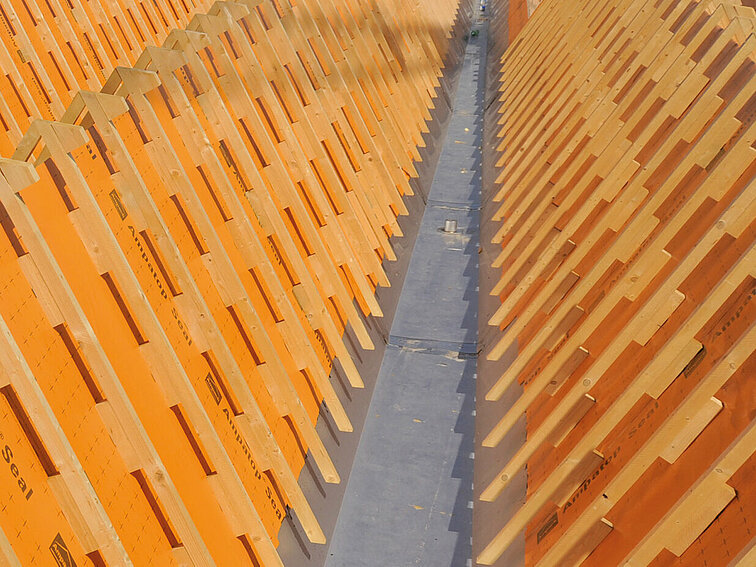Roof
Why build a windtight house?

A house that is windtight should also be airtight. Why are these terms which are so similar in meaning so clearly separated from each other?
The answer is obvious and simple: Whilst the airtight layer prevents the warm indoor air from escaping from the building, the windtight layer protects the thermally insulated construction from the cold external air. The wind seal is mainly used for ventilated façades. In the case of roofs the membrane fulfils the function of the wind seal. A non-airtight outer covering inevitably leads to damage due to moisture in the thermal insulation and the supporting structure. Cold external air penetrates through the inadequate building shell reaching the inner lining. Due to the cooling-off of the inner lining surface condensation forms, which can result in discolouration or even mould formation. In addition, all the air circulation within the thermal insulation reduces its efficacy.
Whereas the airtight layer is generally to be found on the warm side of the construction, the wind seal is on the cold side. In a thermally insulated light construction or wooden construction it is important that neither the airtight layer nor the windtight layer is missing. Whilst it is advantageous if the airtight layer is constructed as an airtight vapour retardant, the wind seal must be as vapour-permeable as possible. In this way a structurally perfect, long-lasting and breathable building shell can be achieved.
The benefits of a windtight building shell
- Optimum thermal insulation
- Low energy consumption
- No mould attacks
- Does not attract pests
- Wood preservative is not required
- Protection from snow, wind, etc. during the construction period
- Maintenance of the protective function over the building's economic useful life
- Increase in value of the building
Simply irreplaceable: A perfect roof

The roof fulfils many functions: Architecture, protection against the weather, thermal insulation, homeliness. Many important tasks for a building component only 45 cm thick! Therefore it is essential that each layer carries out its function correctly and works well together as a whole.
On the one hand, the roof is the part of the house that faces the heaviest demands. On the other hand, the condition of the roof has an effect on the whole of the rest of the house. Optimum thermal insulation and rain-proofness are fundamental requirements to ensure that the house occupants feel safe and comfortable.
The double function of the roof
The roof construction serves a double function: Protection from the weather and thermal insulation. Roof membranes protect against dust, blowing snow, driving rain and the infiltration of cold air into the thermal insulation. A fully functional roof is essential to ensure that the thermal insulation can do its job without any restrictions.
Second water-bearing level
Roof membranes also act as a second water-bearing layer, which is of particular importance if the primary
drainage level is damaged. Since it is this second water-bearing level alone that protects the building from damage in the case of defective roofing materials, it is essential that it should meet the highest quality requirements.
Roof membrane as additional measure
A roof membrane can also provide a (required) additional measure for the roof covering in certain conditions. Depending on the
- position,
- roof pitch,
- climatic conditions,
- altitude,
- local influences or
- use and / or conversion of the roof space
different materials and structures are required. Ampack provides roof membranes for the most disparate of roofing constructions, e.g. for standard roofs, flat-pitched roofs and roofs for specific specifications. There are products that can be used from as little as a 5° roof pitch. The regulations issued by the ZVDH governing roof pitch must be observed.




